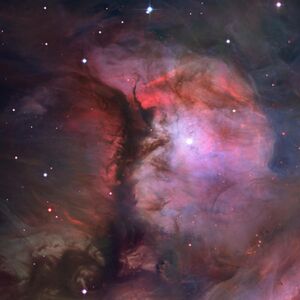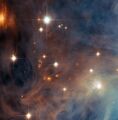Astronomy:Messier 43
| Emission nebula | |
|---|---|
| H II region | |
 Emission nebula Messier 43 in Orion | |
| Observation data: J2000 epoch | |
| Right ascension | 05h 35m 31.8s[1] |
| Declination | −05° 17′ 57″[1] |
| Distance | 1,300 ± 160 ly (400 ± 50 pc) ly |
| Apparent magnitude (V) | 9.0[2] |
| Apparent dimensions (V) | 20′ × 15′[3] |
| Constellation | Orion |
| Notable features | Trapezium cluster |
| Designations | De Mairan's Nebula, M43, NGC 1982[4] |
Messier 43 or M43, also known as De Mairan's Nebula and NGC 1982, is a star-forming nebula with a prominent H II region in the equatorial constellation of Orion. It was discovered by the French scientist Jean-Jacques d'Ortous de Mairan some time before 1731,[3] then catalogued by Charles Messier in 1769.[lower-alpha 1] It is physically part of the Orion Nebula (Messier 42), separate from that main nebula by a dense lane of dust known as the northeast dark lane.[5] It is part of the much larger Orion molecular cloud complex.
The main ionizing star in this nebula is HD 37061 (variable star designation NU Ori[lower-alpha 2]), the focus of the H II region, 1,300 ± 160 ly (400 ± 50 pc) away.[lower-alpha 3] This is a triple star system with the brighter component being a single-lined spectroscopic binary. The main component is a blue-white hued B-type main-sequence star with a stellar classification of B0.5V or B1V. It has 19±7 times the mass of the Sun (M☉) and 5.7±0.8 times the Sun's radius (R☉). It is radiating over 26,000 times the Sun's luminosity (Template:Lo) from its photosphere at an effective temperature of 31,000 K. It is spinning rapidly with a projected rotational velocity of around 200 km/s.[5]
The H II region is a roundish volume of ionized hydrogen. It has a diameter of about 4.5′, at its distance meaning it measures 2.1 ly (0.65 pc). The net (meaning omitting the star) hydrogen alpha luminosity of this region is (3.0±1.1)×1035 erg s−1; equivalent to 78 solar luminosity. There is a dark lane crossing the whole west-centre strip from north to south, known as the M43 dark lane, which forming a swirling belt extension to the south links to Orion's northeast dark lane. All of these resemble a mixture of smoke rising from a chimney and in watercolour broad and fine dark brushstrokes, at many wavelengths.
Gallery
See also
References and footnotes
- ↑ Jump up to: 1.0 1.1 Sulentic, Jack W. et al. (1973), The revised new catalogue of nonstellar astronomical objects, Tucson: University of Arizona Press, Bibcode: 1973rncn.book.....S.
- ↑ "Messier 43". https://messier.seds.org/m/m043.html.
- ↑ Jump up to: 3.0 3.1 Adam, Len (2018), Imaging the Messier Objects Remotely from Your Laptop, The Patrick Moore Practical Astronomy Series, Springer, p. 209, ISBN 978-3319653853, Bibcode: 2018imor.book.....A, https://books.google.com/books?id=7nNUDwAAQBAJ&pg=PA209.
- ↑ "M 43". SIMBAD. Centre de données astronomiques de Strasbourg. http://simbad.u-strasbg.fr/simbad/sim-basic?Ident=M+43.
- ↑ Jump up to: 5.0 5.1 Simón-Díaz, S. et al. (June 2011), "A detailed study of the H ii region M 43 and its ionizing star", Astronomy & Astrophysics 530: 13, doi:10.1051/0004-6361/201116608, A57, Bibcode: 2011A&A...530A..57S.
External links
| Wikimedia Commons has media related to Messier 43. |
- Garner, Rob, ed. (October 19, 2017), Messier 43, NASA, https://www.nasa.gov/feature/goddard/2017/messier-43, retrieved 2018-11-26.
- Frommert, Hartmut; Kronberg, Christine (October 8, 2018), Messier 43: De Mairan's Nebula, Companion of the Orion Nebula, Students for the Exploration and Development of Space (SEDS), http://messier.seds.org/m/m043.html, retrieved 2018-11-26
- Messier 43 on WikiSky: DSS2, SDSS, GALEX, IRAS, Hydrogen α, X-Ray, Astrophoto, Sky Map, Articles and images
Coordinates: ![]() 05h 35.6m 00s, −05° 16′ 00″
05h 35.6m 00s, −05° 16′ 00″
 |



